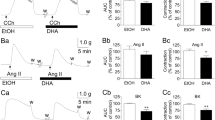Abstract
IT has been shown by Majno et al.1 that a strip of growing granulation tissue (GT) cut from the wall of a 2- to 4-week-old granuloma pouch2 or from the base of an open wound in the rat, contracts in vitro in response to 107–106 concentrations of 5-hydroxytryptamine, angiotensin and other agonists. An association between this pharmacological reactivity of GT and the phenomenon of wound contraction has been proposed1 on the bases that the forces which cause a wound to contract are cellular in origin and generated by GT cells3,4, and that fibroblasts proliferating in vitro and in vivo develop a muscle-like cytoarchitecture characterised by an increase in the number of microfilaments5. Also fibroblasts in culture contain abundant microtubules6 which can be rapidly destroyed by poisons such as colchicine6–8 that prevent polymerisation of the tubular protein. For example colchicine can prevent microtubules comprising the mitotic spindle from forming and thereby inhibit karyokinesis (separation of chromosomes)9. The drug seems not to affect the functions of microfilaments, on which various types of contractile activity, including cytokinesis, depend10; the microfilaments are specifically inhibited by the drug cytochalasin B (ref. 11).
This is a preview of subscription content, access via your institution
Access options
Subscribe to this journal
Receive 51 print issues and online access
$199.00 per year
only $3.90 per issue
Buy this article
- Purchase on Springer Link
- Instant access to full article PDF
Prices may be subject to local taxes which are calculated during checkout
Similar content being viewed by others
References
Majno, G., Gabbiani, G., Horschel, B. J., Ryan, G. B., and Stratkov, P. R., Science, 173, 548 (1971).
Selye, H., J. Am. Med. Ass., 152, 1207 (1952).
Billingham, R. E., and Russel, P. S., Ann. Surg., 144, 961 (1956).
van den Brenk, H. A. S., Orton, C., Stone, M., and Kelly, H., Int. J. Radiat. Biol., 25, 1 (1974).
Gabbiani, G., Ryan, G. B., and Majno, G., Experientia, 27, 549 (1971).
Goldman, R. D., J. Cell Biol., 51, 752 (1971).
Taylor, E. W., J. Cell Biol., 25, 145 (1965).
Borisy, G. G., and Taylor, E. W., J. Cell Biol., 34, 535 (1967).
Dustin, P., Pharmac. Rev., 15, 449 (1963).
Wessels, N. K., Spooner, B. S., Ash, J. F., Bradley, M. O., Luduena, M. A., Taylor, E. L., Wrenn, J. T., and Yamada, K. M., Science, 171, 135 (1971).
Carter, S. B., Nature, 213, 261 (1967).
Mitchison, J. M., The Biology of the Cell Cycle, 193 (Cambridge University Press, London, 1971).
Zeuthen, E., C.r. Trav. Lab. Carlsberg, 25, 191 (1946).
Ishikaiva, H., Bishoff, R., and Halzer, H., J. Cell Biol., 38 538 (1968).
Van Rossum, J. M., and van den Brink, F. G., Archs int. Pharmacodyn. Ther., 143, 240 (1963).
Author information
Authors and Affiliations
Rights and permissions
About this article
Cite this article
VAN DEN BRENK, H., STONE, M. Actions and interactions of colchicine and cytochalasin B on contraction of granulation tissue and on mitosis. Nature 251, 327–329 (1974). https://doi.org/10.1038/251327a0
Received:
Issue Date:
DOI: https://doi.org/10.1038/251327a0
This article is cited by
-
The effect of intraperitoneal colchicine on the formation of peritoneal adhesions in the rat
Archives of Gynecology (1982)
-
Colchicine-induced abnormal meiotic chromosomal segregation in primary oocytes of the Chinese hamster
Japanese journal of human genetics (1980)
-
Melatonin antagonizes colchicine-induced mitotic arrest
Experientia (1976)
Comments
By submitting a comment you agree to abide by our Terms and Community Guidelines. If you find something abusive or that does not comply with our terms or guidelines please flag it as inappropriate.



